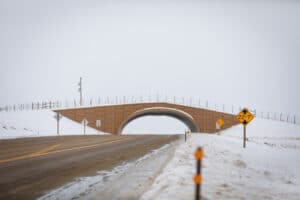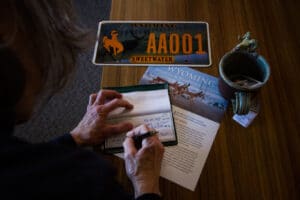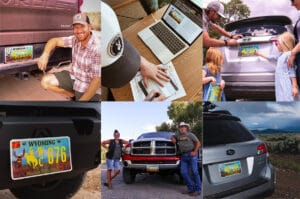Wyoming’s roadways see some of the highest rates of vehicle/ wildlife collisions anywhere in the United States. Working to reduce the hazard not only benefits wildlife but, also greatly helps reduce the number of human fatalities and injuries. Through a committed and strategic approach, The Federation’s staff and membership are constantly working on ways to reduce wildlife and roadway conflicts in Wyoming.
Wyoming’s wildlife and roadways are both important resources to the state’s economy and heritage, yet they often come into conflict. When big game cross roadways, it can be dangerous for motorists and for the animals. Fifteen percent of all reported vehicle collisions in Wyoming involve big game animals. Although the vast majority of accidents involve deer, vehicles also hit larger animals like elk and moose, and these collisions are usually more dangerous than collisions involving smaller animals.
Every year, more than 6,000 deer, pronghorn, elk and moose are hit by vehicles on Wyoming’s roads. These accidents cost nearly $50 million annually in damages to vehicles, human injury expenses and loss of wildlife. When vehicles and big game collide, it is not only a safety hazard for humans; it is also bad for the wildlife. Nearly all animals hit by vehicles are killed. Roadway collisions cause avoidable deaths for many big game herds, some of which are already in decline. Traffic and roadside fences make it stressful, difficult or even impossible for animals to cross roads. This interferes with the animals’ ability to follow their migration routes or access the food and habitat they need to thrive. Fortunately, there are steps we can take to reduce the conflicts between roads and wildlife.
NEXT STEPS
The Wyoming Wildlife and Roadways Initiative began in 2017, with the Wyoming Wildlife and Roadways Summit. At this event, more than 130 representatives from government and non-governmental organizations, as well as scientists and members of the public, gathered to share ideas about how to reduce the problem of roads and wildlife. The Wyoming Wildlife and Roadways Initiative Implementation Team was formed to take the summit recommendations forward.
The team identified more than 240 sites around the state that are the greatest concern for wildlife and motorists. The two agencies are already working together at a local level to address many of these sites. Using best available data and expert knowledge, the team identified a smaller group of 40 sites that are both high priority and may require more involved and costly solutions such as crossing structures.
HOW DO WE FUND THESE PROJECTS?
Conservation License Plates
The Wyoming Wildlife Federation staff and members are hard at work funding these crossings projects. In 2018, the Federation’s legislative team helped pass a new Conservation License Plate in Wyoming. Funds generated from the Conservation Plate help fund overpasses, underpasses, fencing and signage to prevent vehicle/animal collisions. $150 of each plate purchased will go to the Wildlife Conservation Fund, as well as $50 from the plate’s renewal each year.
As of early 2021, Wyomingites raised more than $300K for wildlife crossings through the conservation plates alone.
Wyoming Department of Transportation Donations
As of 2019, two bills the Federation helped pass allowed WYDOT to gain more money for crossings. One allowed anyone registering a vehicle, including snowmobiles and off-road recreational vehicles, in Wyoming to donate an additional amount to wildlife conservation efforts related to the transportation system. When passed, this bill gave all Wyomingites seeking to register any motorized vehicle an opportunity to donate to the Wildlife Conservation Account. Another bill establishes a stamp (like the conservation stamp associated with hunting and fishing licenses) that people can purchase. All proceeds go toward wildlife conservation efforts related to the transportation system. It also expands the reach of soliciting voluntary donations beyond the residents of Wyoming.
Wyoming Wildlife Natural Resource Trust (WWNRT)
The Wyoming Wildlife and Natural Resource Trust program was established by the Wyoming Legislature in 2005 to provide adequate funding to maintain and enhance Wyoming’s incredible natural resources. Within this mission, WWNRT has helped fund multiple crossings projects and continues to be a great source of grants for key wildlife crossings projects. The Federation helps raise funds for WWNRT throughout various avenues, including advocating for a $75M infusion from the Wyoming state budget during the 2022 legislative session. This influx of money nearly fully funded the trust and will allow it to operate at it’s intended full capacity.
Latest Related News
10 High Priority Areas for Wildlife Crossings
Originally identified by the Wyoming Wildlife and Roadways Initiative Implementation Team (WWRIIT), there are 240 sites that are both important and may require more involved and costly solutions, like tall fencing to use existing underpass structures, and overpass structures like the ones at …
Artists & Coffee Shop Make An Impact For Wildlife Crossings
Back in December and January, artists Jenny Reeves-Johnson and Noelle Weimann of the Sweetwater Studio in Lander, WY teamed up with the hopping coffee shop, Cowboy Coffee Co. in Jackson, WY, to raise money for wildlife crossings. This art show, lovingly named “Share …
Artists & Coffee Shop Make An Impact For Wildlife Crossings Read More »
Wyomingites Raise $300K For Wildlife With License Plates
A year ago Governor Gordon challenged Wyoming citizens to purchase 2,020 wildlife conservation license plates. Wyomingites responded, raising over $300,000 for signage, fences, underpasses and overpasses that help wildlife cross Wyoming roadways safely. Three years ago, during the legislative session of 2018, the …
Wyomingites Raise $300K For Wildlife With License Plates Read More »
What We Do To Help
Wyoming Wildlife Federation has a number of specific Programs that address this
issue directly. Click on a Program in the list below to explore it in depth.
WANT TO HELP FUND OUR WORK? MAKE A DONATION
Help Protect Our Way of Life
We need everyone who values the wild spaces of Wyoming to get involved. Are you ready?




